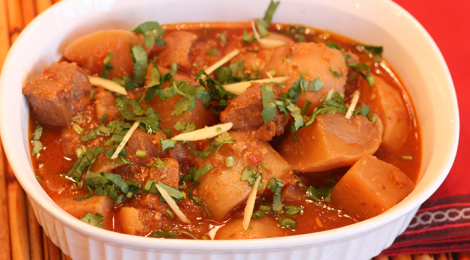
Shaljam Gosht
Shaljam gosht. It’s not glamorous, it’s not served on parties, but being a Pishori, I can only admit that it is one of my all time favorite meals. Shaljam, [or shalgham in Urdu, thippar in Hindko, taperr (tay-PER) in Pashto or gongloo as they are known in Punjabi] were a staple in our house growing up, and I loved them whether they were served with white rice, (a winning combination) or, with roti kootofied (small pieces of fresh made roti mixed into the salan or gravy by hand), with a dollop of yogurt.
When I was around 10, we took a trip to the Northern Mountains. In Kalam, we spotted some freshly grown turnips. There are few crops that can grow in the harsh climate and terrain of the mountains, and root vegetables like potatoes and turnips are two of the most commonly cultivated crops. My father bought about a ton of them and handed them over to the hotel staff to cook for us. While we were waiting for our meal, my brother and I started discussing turnips. I told him that I really liked them, and he said to me that the only time that a turnip can be considered ‘good’ is when it is so tender that as soon as you touch it, it completely dissolves. I emphatically agreed.
Unfortunately, at such a high altitude, it takes forever to cook anything, and a tough vegetable like the turnip? Forget it. Not to mention the very large quantity. We waited and waited and waited, and were finally served the rather less than tender shaljam gosht. Now, just to prove to my brother that I really meant when I said that I liked them, I ate a lot, although I’m sure he wasn’t keeping tabs on how much I was eating. Such a waste! Because I couldn’t look at turnips for a while after that. Kids do silly things!
The day came when I was making my first shaljam gosht in America, and I did not forget that lesson. They did turn out to be tender, but that was the time when it used to take me a full working day to make one (very dark brown) dish. Somehow, it just wasn’t the yummy taste of my mother’s shaljam gosht. But now finally, AH, six years later, I can say that my extremely vegetable averse husband also happily enjoys my shaljam gosht.
In the Punjab, turnips are made completely mashed, with or without meat. Another popular dish is the shab deg, which is a kind of stew made with meat and turnips, but the special thing about it is that it uses whole turnips, and the stew is cooked on low heat all night long. It sounds very good, but I have to admit that I’m not brave enough to try it at home!
The main reason that I wanted to do this post now is that turnips are in season! Yay! Although you can get turnips all year around, in the spring and summer, the inside of the turnip is dry and webbed. They cook up webbed and stringy too, and are quite unappetizing. These days they are fresh, firm and vibrant, the inside a smooth, creamy white. Enjoy them while you can. I have completely stopped making them out of season.
The other very important thing is knowing how to cut them. I have mentioned that they are quite hard. After you are done peeling them, take a very sharp knife, and cut in a sliding motion, cutting with the top of the knife first, and then sliding it down, using your wrist, to cut through. You know, the way chefs do it on TV. So important. If you try to cut through the turnip while holding the knife horizontal and parallel with your work surface, the knife will slip, the turnip will fly and there will be a lot of blood to clean up.
[Note: The turnips are traditionally cut into large chunks for this dish.]
Shaljam Gosht
Ingredients:
- 1 lb beef (or mutton)
- ¼ cup oil
- 2 onions
- 2 tomatoes
- 1 tbsp yogurt (optional)
- 1 tbsp garlic
- 1 tbsp ginger
- ¼ tsp turmeric
- 1 heaped tsp salt
- ½ tsp red chillies
- 1 heaped tsp coriander powder
- 1 heaped tsp cumin
- touch of oregano (optional)
- 1-2 green chillies, halved (optional)
- 5 medium turnips
- 3 tbsp sugar
- Cilantro and ginger for garnishing
Method:
Finely chop the onions and tomatoes and fry them in the oil until they turn a light brown color. Add the ginger, garlic, yogurt, green chillies and all the spices. Stir fry for a minute or two. Add the meat and stir fry for a few minutes on almost high heat until it is no longer pink and gives off a roasted aroma.
Add the turnips and stir fry until well coated with the spice mixture.
Add 4 cups of warm water and bring to a simmer. Reduce the heat almost to low (the water should still be simmering), cover and cook for about 1-1½ hours or until the meat and the turnips are fork tender.
Half way through the cooking, add the sugar. When they are done, reduce the gravy to your liking (shaljam gosht usually has a good amount of gravy) and adjust the seasoning.
Garnish with chopped cilantro leaves and thinly sliced ginger and serve hot with white rice or roti.
Notes:
We’ve established that the turnips have to be very, very tender. But since it takes them a while to cook, your dish will be in danger of becoming very dark in color. For this reason, I fry the onions to a very pale, just starting to turn light brown, color. Shaljam gosht should be a very appetizing golden color.
Secondly, I throw in the turnips with the meat. Usually, the meat is cooked until tender first, then the turnips and sugar are added, bhoonofied, and then simmered until the turnips are cooked through. But my method saves me some time. Plus, as mentioned before, if you’re cooking the meat first then adding the turnips, then the dish will only keep getting darker and darker.
I don’t use a pressure cooker. I don’t want anything to blow up in my kitchen, because then I’ll have to clean up all the mess and make dinner again from scratch. I have other things to worry about. But if you use it regularly, then it can really save you some time.
Enjoy the seasonal flavors as they come!
Please ‘like’ Zabiha Bites on Facebook.
Related Post:





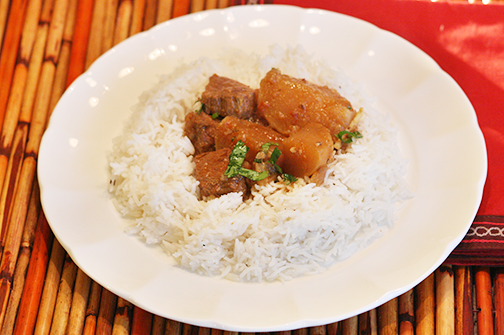
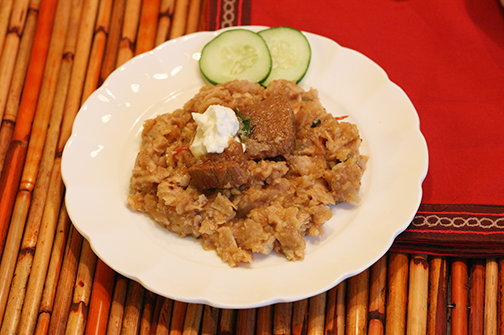
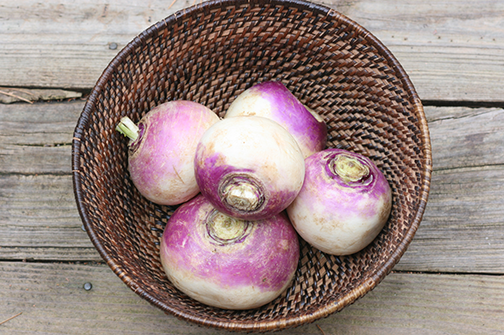

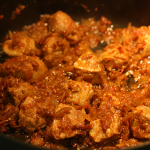
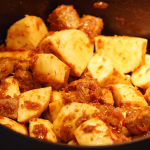
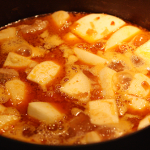
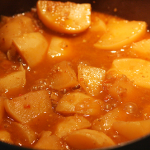

thank you bino bibi for this wonderful memory of my dad. i am very proud to be his daughter.
My pleasure meri jan.
The true flavor of kootofied bread in shaljam curry can be tasted if you eat it with your fingers instead of a spoon.
Very true.
Amina, I’ve shared a memory associated with shaljam gosht. See if you like it.
Turnips and meat seems to be a very pedestrian dish but as you said, it has always been a favorite in our family. Due to this reason, there are some very poignant family memories associated with this dish.
When we lived in Islamia College, our house was built in the old-fashioned way with the kitchen being at a distance from the rest of the rooms. Consequently, we used to have our meals in the kitchen with my mother presiding over the pots and pans, ladling out plates for all of us.
Once, in the month of Ramadan, my mother had made our favorite turnips and meat with boiled rice for iftar. My younger brother, who had a big appetite at that age, used to have his food in a platter rather than a plate. While having our meal, suddenly we felt the ground move beneath our feet. All of us looked at each other in horror and ran outside helter-skelter.
Outside, in the courtyard, holding our mother’s hands, all of us recited surahs from the Holy Quran, praying for Allah’s mercy. In the darkness, the trees swaying to a mad rhythm added to the terror of the scene. In a few seconds, the tremors stopped and we looked around. Spontaneous laughter spouted out when we saw our younger brother, shoveling in mouth-fulls. Even under those terrifying conditions, he had the presence of mind to grab his platter and bring it outside with him. We were all convinced of his fearless disposition.
This little incidence of courage in face of adversity portrayed an integral part of his personality. At the time of the Ojhri Camp disaster in 1988, when he could have saved himself, he chose to lay down his life to save the soldiers who were trapped in one of the buildings. He saved them, but sacrificed his own life in the process. May Allah rest his soul in eternal peace and may the angels serve him the choicest dishes in platters of gold in his eternal abode in heaven.
Ameen. Mamu was so funny! And cheerful! Truly golden!